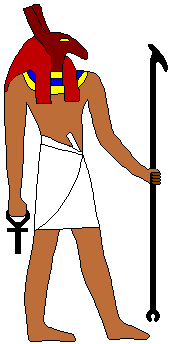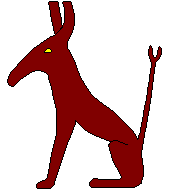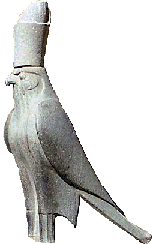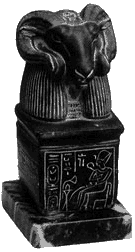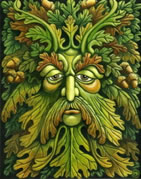
Bast
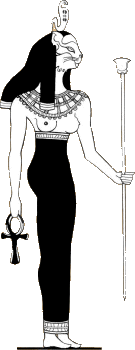
Bast, Perfumed Protector, Cat Goddess
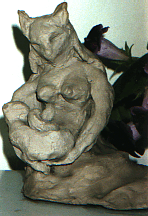
Statue: 600 B.C.E.
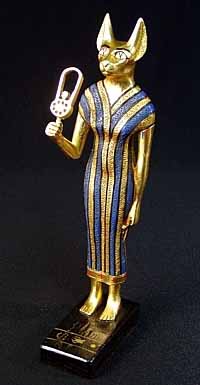
In Egyptian mythology, Bast (also spelled Ubasti, Baset, and later Bastet) is an ancient solar and war goddess, worshipped at least since the Second Dynasty. In the late dynasties, the priests of Amun began to call her Bastet, a repetitive and diminutive form after her role in the pantheon became diminished as Sekhmet, a similar lioness war deity, became more dominant in the unified culture of Lower and Upper Egypt. In the Middle Kingdom, the cat appeared as Bastet¹s sacred animal and after the New Kingdom she was depicted with a woman with a cat¹s head carrying a sacred rattle and a box or basket.
Bast or Bastet was the cat goddess and local deity of the town of Bubastis or Per-Bast in Egyptian, where her cult was centered. Bubastis was named after her. Originally she was viewed as the protector goddess of Lower Egypt, and consequently depicted as a fierce lioness. Indeed, her name means (female) devourer.[citation needed] As protector, she was seen as defender of the pharaoh, and consequently of the later chief male deity, Ra, who was a solar deity also, gaining her the titles Lady of Flame and Eye of Ra.
The goddess Bast was sometimes depicted holding a ceremonial sistrum in one hand and an aegis in the other the aegis usually resembling a collar or gorget embellished with a lioness head.
Bast was a goddess of the sun throughout most of Ancient Egyptian history, but later when she was changed into a cat goddess rather than a lion, she was changed to a goddess of the moon by Greeks occupying Ancient Egypt toward the end of its civilization. In Greek mythology, Bast is also known as Aelurus.
History and Connection to Other Hods
Due to the threat to the food supply that could be caused by simple vermin such as mice and rats, and their ability to fight and kill snakes, especially cobras, cats in Egypt were revered highly, sometimes being given golden jewellery to wear and were allowed to eat from the same plates as their owners. Consequently, later as the main cat (rather than lioness) deity, Bastet was strongly revered as the patron of cats, and thus it was in the temple at Per-Bast that cats were buried and mummified.
When the owner died they would put the owner next to the mummified cat. More than 300,000 mummified cats were discovered when Bast's temple at Per-Bast was excavated. Herodotus writes that when a cat in the family dies, Egyptians shaved their eyebrows and took the body to Bubastis to be embalmed.
As a cat or lioness war goddess, and protector of the lands, when, during the New Kingdom, the fierce lion god Maahes of Nubia became part of Egyptian mythology, she was identified, in the Lower Kingdom, as his mother. This paralleled the identification of the fierce lioness war goddess Sekhmet, as his mother in the Upper Kingdom.
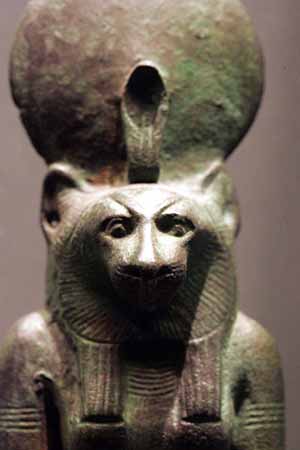
Wadjet-Bast, with a lioness head, the solar disk, and the cobra
As divine mother, and more especially as protector, for Lower Egypt, she became strongly associated with Wadjet, the patron goddess of Lower Egypt, eventually becoming Wadjet-Bast, paralleling the similar pair of patron (Nekhbet) and lioness protector (Sekhmet) for Upper Egypt. Bastet was the daughter of Amun Ra.
Later Perception
Later scribes sometimes renamed her Bastet, a variation on Bast consisting of an additional feminine suffix to the one already present, thought to have been added to emphasize pronunciation; but perhaps it is a diminutive name applied as she receded in the ascendancy of Sekhmet in the Egyptian pantheon. Since Bastet literally meant, (female) of the ointment jar, Bast gradually became regarded as the goddess of perfumes, earning the title perfumed protector. In connection with this, when Anubis became the god of embalming, Bast, as goddess of ointment, came to be regarded as his wife. The association of Bastet as mother of Anubis, was broken years later when Anubis became Nephthys' son.
Egypt's loss in the wars between Upper and Lower Egypt led to a decrease in her ferocity. Thus, by the Middle Kingdom she came to be regarded as a domestic cat rather than a lioness. Occasionally, however, she was depicted holding a lioness mask, hinting at potential ferocity. Because domestic cats tend to be tender and protective of their offspring, Bast was also regarded as a good mother, and she was sometimes depicted with numerous kittens. Consequently, a woman who wanted children sometimes wore an amulet showing the goddess with kittens, the number of which indicated her own desired number of children.
Eventually, her position as patron and protector of Lower Egypt led to her being identified with the more substantial goddess Mut, whose cult had risen to power with that of Amun, and eventually being syncretized with her as Mut-Wadjet-Bast. Shortly after, Mut also absorbed the identities of the Sekhmet-Nekhbet pairing as well.
This merging of identities of similar goddesses has led to considerable confusion, leading to some attributing to Bastet the title Mistress of the Sistrum (more properly belonging to Hathor, who had become thought of as an aspect of the later emerging Isis, as had Mut), and the Greek idea of her as a lunar goddess (more properly an attribute of Mut) rather than the solar deity she was. Indeed, much of this confusion occurred with subsequent generations; the identities slowly merged among the Greeks during their occupation of Egypt, who sometimes named her Ailuros (Greek for cat), thinking of Bastet as a version of Artemis, their own moon goddess.Thus, to fit their own cosmology, to the Greeks Bastet is thought of as the sister of Horus, whom they identified as Apollo (Artemis' brother), and consequently, the daughter of the later emerging deities, Isis and Ra.
The worship of the Goddess Bast continues today through Khemetic reconstructionalist religions, there are several 'Bast Cults' some of which may be found online and as such, technically, predates most Religions. In current day it is very common for Bast to be seen as a fertility goddess or even a goddess of lesbianism, despite the fact that research on her actual functions within the Egyptian pantheon is so very easy.

Hathor - the Goddess of love, music, dance |
cow horns and sundisk on head |
|
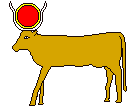
|
Sekhmet - the Goddess of the sun |
woman with lion's head head |
|
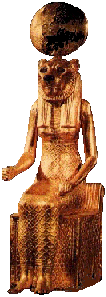
 Hathor was the goddess of joy, motherhood, and love. She looked after all women. She was the goddess of music and dancing, as well. Dead women were identified with Hathor, as men were identified with Osiris. She has a sun disk on her head and cow horns. Sometimes she had cow's ears or was a whole cow.
Hathor was the goddess of joy, motherhood, and love. She looked after all women. She was the goddess of music and dancing, as well. Dead women were identified with Hathor, as men were identified with Osiris. She has a sun disk on her head and cow horns. Sometimes she had cow's ears or was a whole cow.
But she had another side as well, as Sekhmet, the Eye of Ra, the destructive Sun Goddess. The Egyptians knew that the Sun brought life, but they also knew that the desert Sun could kill you.
Ra, the Sun God, was angry with mankind, because they laughed at him. He said that he'd send down his anger as Sekhmet, the Eye of Ra. She went down to Earth, killing men, and drinking their blood. She started to frighten Ra, who only wanted to punish Mankind, not destroy them all. So he dyed some beer red, to look like blood. When Sekhmet saw the beer, she was thristy for blood, so she drank it all, got drunk and went to sleep. When she woke up, Ra persuaded her to stop killing Mankind.

Hathor - the Goddess of love, music, dance |
cow horns and sundisk on head |
|
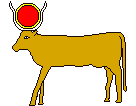
|
Sekhmet - the Goddess of the sun |
woman with lion's head head |
|
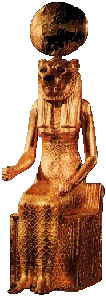
 Hathor was the goddess of joy, motherhood, and love. She looked after all women. She was the goddess of music and dancing, as well. Dead women were identified with Hathor, as men were identified with Osiris. She has a sun disk on her head and cow horns. Sometimes she had cow's ears or was a whole cow.
Hathor was the goddess of joy, motherhood, and love. She looked after all women. She was the goddess of music and dancing, as well. Dead women were identified with Hathor, as men were identified with Osiris. She has a sun disk on her head and cow horns. Sometimes she had cow's ears or was a whole cow.
But she had another side as well, as Sekhmet, the Eye of Ra, the destructive Sun Goddess. The Egyptians knew that the Sun brought life, but they also knew that the desert Sun could kill you.
Ra, the Sun God, was angry with mankind, because they laughed at him. He said that he'd send down his anger as Sekhmet, the Eye of Ra. She went down to Earth, killing men, and drinking their blood. She started to frighten Ra, who only wanted to punish Mankind, not destroy them all. So he dyed some beer red, to look like blood. When Sekhmet saw the beer, she was thristy for blood, so she drank it all, got drunk and went to sleep. When she woke up, Ra persuaded her to stop killing Mankind.

Hathor - the Goddess of love, music, dance |
cow horns and sundisk on head |
|
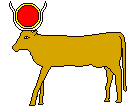
|
Sekhmet - the Goddess of the sun |
woman with lion's head head |
|
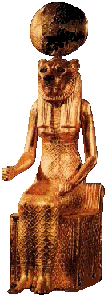
 Hathor was the goddess of joy, motherhood, and love. She looked after all women. She was the goddess of music and dancing, as well. Dead women were identified with Hathor, as men were identified with Osiris. She has a sun disk on her head and cow horns. Sometimes she had cow's ears or was a whole cow.
Hathor was the goddess of joy, motherhood, and love. She looked after all women. She was the goddess of music and dancing, as well. Dead women were identified with Hathor, as men were identified with Osiris. She has a sun disk on her head and cow horns. Sometimes she had cow's ears or was a whole cow.
But she had another side as well, as Sekhmet, the Eye of Ra, the destructive Sun Goddess. The Egyptians knew that the Sun brought life, but they also knew that the desert Sun could kill you.
Ra, the Sun God, was angry with mankind, because they laughed at him. He said that he'd send down his anger as Sekhmet, the Eye of Ra. She went down to Earth, killing men, and drinking their blood. She started to frighten Ra, who only wanted to punish Mankind, not destroy them all. So he dyed some beer red, to look like blood. When Sekhmet saw the beer, she was thristy for blood, so she drank it all, got drunk and went to sleep. When she woke up, Ra persuaded her to stop killing Mankind.

Nut - the Sky Goddess |
blue with golden stars |
|
|
Geb - the Earth God |
colour of plants and fertile Nile mud |
|
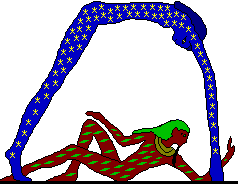 The sky is Nut's body, arching from horizon to horizon. Geb is the Earth, lying beneath her. During the day, Nut and Geb are separated, but each evening Nut comes down to meet Geb and this causes darkness. If storms came during the day, it was believed that Nut had come closer to the earth.
The sky is Nut's body, arching from horizon to horizon. Geb is the Earth, lying beneath her. During the day, Nut and Geb are separated, but each evening Nut comes down to meet Geb and this causes darkness. If storms came during the day, it was believed that Nut had come closer to the earth.
 Nut was married to the King of the Gods, Ra, but she was in love with Geb. When Ra found out, he was angry and said that Nut could not give birth to any children during the 360 days of the year. Nut was unhappy and asked the God of Wisdom, Thoth, to help. At this time, the Moon was as bright as the Sun. Thoth got some light from the Moon, so now the Moon gets bigger and smaller each month. With this light, Thoth made five new days, so now the year is 365 days long. Nut gave birth to her five children, on these five days. When Osiris, the oldest, was born, a loud voice said "The lord of all the earth is born." Seth, his brother, was born hating Osiris. If you want to know what Seth did to Osiris, go to Osiris' page.
Nut was married to the King of the Gods, Ra, but she was in love with Geb. When Ra found out, he was angry and said that Nut could not give birth to any children during the 360 days of the year. Nut was unhappy and asked the God of Wisdom, Thoth, to help. At this time, the Moon was as bright as the Sun. Thoth got some light from the Moon, so now the Moon gets bigger and smaller each month. With this light, Thoth made five new days, so now the year is 365 days long. Nut gave birth to her five children, on these five days. When Osiris, the oldest, was born, a loud voice said "The lord of all the earth is born." Seth, his brother, was born hating Osiris. If you want to know what Seth did to Osiris, go to Osiris' page.

Nut - the Sky Goddess |
blue with golden stars |
|
|
Geb - the Earth God |
colour of plants and fertile Nile mud |
|
 The sky is Nut's body, arching from horizon to horizon. Geb is the Earth, lying beneath her. During the day, Nut and Geb are separated, but each evening Nut comes down to meet Geb and this causes darkness. If storms came during the day, it was believed that Nut had come closer to the earth.
The sky is Nut's body, arching from horizon to horizon. Geb is the Earth, lying beneath her. During the day, Nut and Geb are separated, but each evening Nut comes down to meet Geb and this causes darkness. If storms came during the day, it was believed that Nut had come closer to the earth.
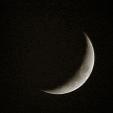 Nut was married to the King of the Gods, Ra, but she was in love with Geb. When Ra found out, he was angry and said that Nut could not give birth to any children during the 360 days of the year. Nut was unhappy and asked the God of Wisdom, Thoth, to help. At this time, the Moon was as bright as the Sun. Thoth got some light from the Moon, so now the Moon gets bigger and smaller each month. With this light, Thoth made five new days, so now the year is 365 days long. Nut gave birth to her five children, on these five days. When Osiris, the oldest, was born, a loud voice said "The lord of all the earth is born." Seth, his brother, was born hating Osiris. If you want to know what Seth did to Osiris,
Nut was married to the King of the Gods, Ra, but she was in love with Geb. When Ra found out, he was angry and said that Nut could not give birth to any children during the 360 days of the year. Nut was unhappy and asked the God of Wisdom, Thoth, to help. At this time, the Moon was as bright as the Sun. Thoth got some light from the Moon, so now the Moon gets bigger and smaller each month. With this light, Thoth made five new days, so now the year is 365 days long. Nut gave birth to her five children, on these five days. When Osiris, the oldest, was born, a loud voice said "The lord of all the earth is born." Seth, his brother, was born hating Osiris. If you want to know what Seth did to Osiris,

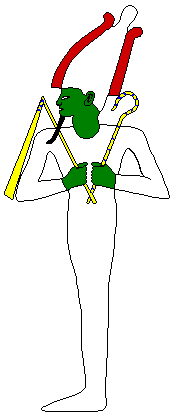
|
Husband of Isis and Father of Horus
Osiris - God of the Dead
dressed in white with crook and flail and white crown |
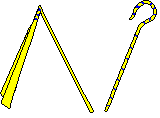 Osiris is shown as a man with a beard wearing white mummy wrappings. His crown is the white crown of Upper Egypt surrounded by red feathers. His skin is green to represent vegetation. He holds the symbols of supreme power, the flail and crook. The crook is used by shepherds to catch their sheep. The flail is used in threshing, to separate the grains from the outer husks. Osiris was the God of the Dead. You would expect that such a god would be gloomy or even evil, but the Egyptians thought about death a lot. They mummified their dead and buried them with their belongings so they could enjoy themselves in the afterlife.
Osiris is shown as a man with a beard wearing white mummy wrappings. His crown is the white crown of Upper Egypt surrounded by red feathers. His skin is green to represent vegetation. He holds the symbols of supreme power, the flail and crook. The crook is used by shepherds to catch their sheep. The flail is used in threshing, to separate the grains from the outer husks. Osiris was the God of the Dead. You would expect that such a god would be gloomy or even evil, but the Egyptians thought about death a lot. They mummified their dead and buried them with their belongings so they could enjoy themselves in the afterlife.
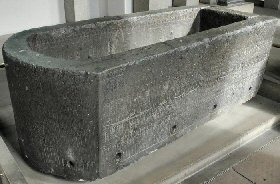 This story begins on Nut and Geb's page. Osiris ruled over the Egyptians and taught them farming. His brother Seth had always hated him, and wanted to kill him. Seth made a beautiful box, like a coffin, made to the exact measurements of Osiris. Then Seth invited Osiris and other people to a great feast. When everyone had finished eating, Seth displayed the box, and said that he'd give it to anyone who fitted inside. Everyone tried, but only Osiris fitted. While he was still inside, Seth and his friends quickly slammed on the lid and threw the box in the Nile river. But what happened next?
This story begins on Nut and Geb's page. Osiris ruled over the Egyptians and taught them farming. His brother Seth had always hated him, and wanted to kill him. Seth made a beautiful box, like a coffin, made to the exact measurements of Osiris. Then Seth invited Osiris and other people to a great feast. When everyone had finished eating, Seth displayed the box, and said that he'd give it to anyone who fitted inside. Everyone tried, but only Osiris fitted. While he was still inside, Seth and his friends quickly slammed on the lid and threw the box in the Nile river. But what happened next?

Brother of Osiris
Seth - God of the desert, storm and violence
animal head with long curved pointed snout |
Seth (or Set) is shown with an animal's head with a long curved pointed snout, slanting eyes, and square-tipped ears. Sometimes he has a forked tail. No-one seems to know what the animal is. Aardvark, antelope, ass, camel, fennec, giraffe, greyhound, jackal, jerboa, long-snouted mouse, okapi, oryx and pig have all been suggested! Seth was the God of the desert, storm and violence, which are all enemies of the fertile, properous, narrow valley of the Nile. 
Seth carries a sceptre, which has his head on top and his tail at the other end. Several other gods seem to carry this sceptre as well. Can you find them?
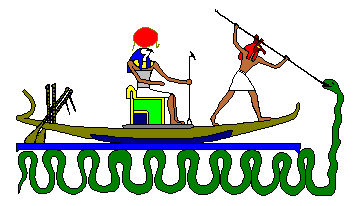 Seth was not always bad. He helped Ra fight the snake Apep.
Seth was not always bad. He helped Ra fight the snake Apep.
This story begins on Nut and Geb's page. Seth had killed Osiris by tricking him into a coffin, which he threw into the Nile. When Osiris' wife Isis heard about this, she started searching desperately for her husband's body, to bury it properly. She asked everyone she met and finally some children told her where it was. Isis mourned for her dead husband. Then she hid the body, while she went back to look after her son Horus, still a baby. Seth was terrified that Isis might be able to bring Osiris back from the dead, since she was a great magician. So Seth found where she had hidden the body and cut it into pieces, which he scattered up and down the Nile. Now Isis had to find all the scattered pieces of Osiris. Whenever she found a piece, she buried it there and built a shrine. This means that there are lots of places in Egypt where Osiris was buried! Osiris himself became the King of the Dead, and all Egyptians hoped they would join him after death. But what happened to Seth?

Son of Isis and Osiris
Horus - Son of Osiris
a hawk, or a man with a hawk's head crowned with the crown of all Egypt |
Horus is shown as a hawk, or a man with a hawk's head and the crown of all Egypt. This makes him look similar to Ra, but Ra is crowned with the sun disk. Horus' crown is made of two parts. The white part is the crown of Upper Egypt (in the south) and the red part is the crown of Lower Egypt (including the Nile delta). Together they show that Horus ruled all Egypt. During their reign, Pharoahs identified themselves with Horus. After they died, they became Osiris.
This story begins on Nut and Geb's page. When Horus was a baby, his father Osiris was killed by Seth. Horus and his mother Isis hid in the papyrus reeds in the delta of the Nile until Horus grew up. The he went to war with Seth to get his father's crown and kingdom. The battles raged for a long time. Once Seth managed to blind Horus by taking out his eye and tearing it to bits, but Thoth, the God of Wisdom, managed to heal the eye. So how did the war end? See Isis's page.
 The Eye of Horus, healed by Thoth, was an amulet, or magic charm. The Ancient Egyptians also used it to describe fractions. The Egyptians sometimes had had two eye symbols, with the left eye being the Eye of Horus, symbolising the moon, and the right eye being symbolising the Eye of Ra, or the sun.
The Eye of Horus, healed by Thoth, was an amulet, or magic charm. The Ancient Egyptians also used it to describe fractions. The Egyptians sometimes had had two eye symbols, with the left eye being the Eye of Horus, symbolising the moon, and the right eye being symbolising the Eye of Ra, or the sun.

Wife of Osiris and Mother of Horus
Isis - Queen of Goddess
with a throne or sun disk and horns on her head |


Isis was the great mother-goddess. Her son was Horus, the enemy of Seth. Sometimes she has the baby Horus on her lap. Sometimes she has a throne on her head, as she is Queen of the goddesses. Sometimes she has a sun disk and horns, like Hathor.
Isis was also a great healer and magician. She got her magic powers by tricking Ra (see Ra's webpage).
This story begins on Nut and Geb's page. The war between Horus and his enemy Seth had lasted a long time. Isis decided to help her son Horus. She met Seth, and asked for his help. She described someone killing a man and taking all he had away from the man's son. Seth said that killer should pay for his crimes. Isis said that Seth himself was the killer, and he had condemned himself. The other gods agreed, and Seth was driven out into the Sahara

Husband of Ma'at
Thoth - God of Wisdom, Time, Writing and the Moon
head of an ibis |
Thoth invented hieroglyphs, the picture writing of Ancient Egypt. He was the measurer of the earth and the counter of the stars, the keeper and recorder of all knowledge. The ibis is a bird rather like a stork, with long legs and a long beak which it uses for prodding in the mud to find small fish. It was a symbol of wisdom and learning because it has a beak shaped like a pen which it dips in the mud, as if it was ink.
The Book of Thoth had two spells in it. If you read the first spell aloud, you would be able to understand every beast and bird, and summon the fishes in the sea. If you read the second spell, you could bring the dead to life. Prince Setna, the son of a Pharaoh, knew the book was hidden in a royal tomb in the City of the Dead. With his brother Anhurerau, he broke into the tomb of Neferkeptah. When they found the burial chamber, they saw the mummy of Neferkaptah, and his wife and young son. The wife spoke to them, and warned them against taking the book of Thoth. She said that her husband had stolen the Book from Thoth, and had read the spells, but Thoth was angry and had drowned her and her son in the Nile, and Neferkeptah had then killed himself. But Setna ignored her and moved towards the Book. The mummy of Neferkaptah sat up and said "Play me at four games of draughts. If you win, you can take the Book." Setna was terrified, but agreed. He played the first game, and lost. He started to sink into the ground, up to his ankles. Then he lost the next game, and sunk up to his hips. As he was losing the third game, he shouted to his brother, "Run and fetch my magic amulets. Only they can save me!" He then sank into the ground up to his chin. His brother ran out of the tomb. Setna played the fourth game as slowly as he could, trying desperately not to lose, but the mummy was too good at draughts. Just as he had nearly lost for the final time, his brother Anhurerau returned with the amulets, and put them on Setna's head. The spell was broken, and Setna grabbed the Book of Thoth, and ran as hard as he could out of the tomb.
As Setna tried to read the Book, he saw a beautiful woman walking past. He fell in love with her, and tried to persuade her to marry him. She demanded that he kill his existing wife and children. Completely besotted with her, he agreed. When he had done this, she vanished, and he was appalled at what he had done. But he discovered that it was all a dream. He realised that he was being punished for stealing the Book of Thoth, and next time it might not be a dream, so he returned the Book to the tomb of Neferkeptah and resealed the burial chamber. Ever since then, no-one has seen the Book of Thoth.
The magic amulet may have been a scarab. The scarab or dung beetle makes a ball of dung by rolling it along the ground, and then lays its eggs in it. The Ancient Egyptians imagined a scarab rolling the sun across the sky.

Anubis - God of Embalming
head of jackal |
Anubis invented embalming to embalm Osiris, the first mummy. He was the guide of the dead. The Egyptians embalmed their dead, especially their pharaohs, to preserve them, since they thought that this helped them live for ever.
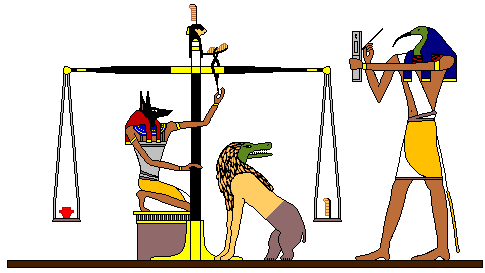
The Ancient Egyptians believed that when you died, you travelled to the Hall of the Dead. There Anubis weighed your heart against the feather of Ma'at. Ma'at, the goddess of justice sits on top of the scales to make sure that the weighing is carried out properly. You can see Anubis steadying the scales to make the weighing fair. If your heart was lighter than the feather, you lived for ever. We still talk of "a heart as light as a feather" to mean care-free, and "heavy-hearted" to mean sad. If your heart was heavier than the feather then it was eaten by the demon Ammit, the Destroyer. Ammit had the head of a crocodile, the shoulders of a lion and the rump of a hippopotamus. These were all frightening animals for the Egyptians. Thoth, god of wisom and writing, stands by to record what happens.

Wife of Thoth
Ma'at - Goddess of Justice
ostrich feather in her hair |

 Ma'at was the goddess of truth, justice and harmony. She was the wife of Thoth, the god of wisdom, since you need wisdom to find truth and justice. Both Ma'at and Thoth helped at the Weighing of the Heart.
Ma'at was the goddess of truth, justice and harmony. She was the wife of Thoth, the god of wisdom, since you need wisdom to find truth and justice. Both Ma'at and Thoth helped at the Weighing of the Heart.

The feather of Ma'at was an ostrich plume. She wore it on her head. The chief judge in charge of the Egyptian law courts was known as the "priest of Ma'at". He began court hearings by wearing the feather of Ma'at. The judge gave the feather to the person who won his case in the law courts.
The pharaoh had to promise that he would follow Ma'at. This means that he would be a just pharaoh, and keep order in Egypt.

|
Amun - God of Creation
crowned with ostrich feathers |
Amun was an important god, but there are no stories about him. He created all things. At the same time, he remained apart from creation, totally different from it, and fully independent from it. In fact, he was invisible, so you couldn't have a picture of him! However, if you called him Amun-Re, this allowed people to see him. Then he had a hat with ostrich feathers on, and like all gods with human heads, a beard. Re is another way of spelling Ra, the sun god.

Tutankhamun's name contains the name of Amun. It also contains the Ankh, which means Life. His name means "Long life to Amun."
The ankh was a very important amulet or magic charm. See how many ankhs you can find on this website!

|
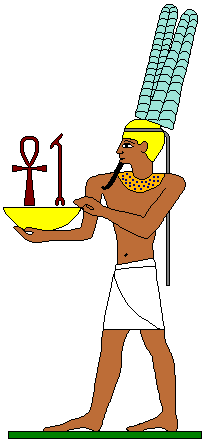
|
 Amun is sometimes spelled Ammon. The fossil ammonites are called after him, because his sacred animal is a ram, and ammonites are shaped like ram's horns.
Amun is sometimes spelled Ammon. The fossil ammonites are called after him, because his sacred animal is a ram, and ammonites are shaped like ram's horns.






































